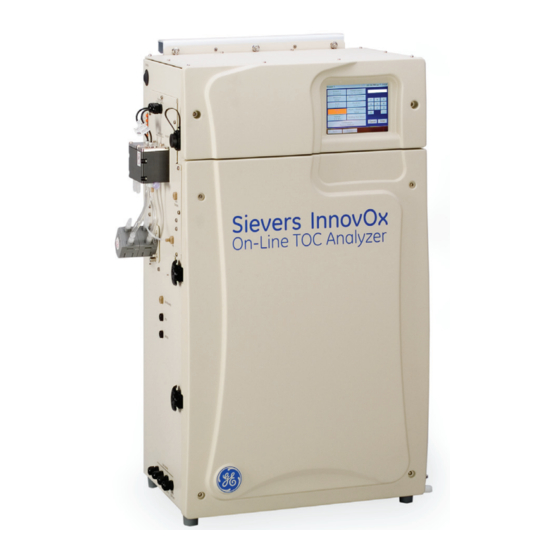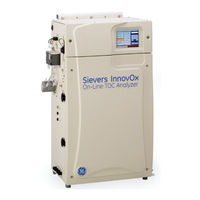
GE Sievers Innovox Manuals
Manuals and User Guides for GE Sievers Innovox. We have 2 GE Sievers Innovox manuals available for free PDF download: Operation And Maintenance Manual
GE Sievers Innovox Operation And Maintenance Manual (270 pages)
TOC analyzer
Brand: GE
|
Category: Analytical Instruments
|
Size: 14.81 MB
Table of Contents
-
Warnings
20 -
-
-
-
Safety67
-
Reliability68
-
-
-
Overview71
-
-
Stream ID
81 -
-
-
-
Overview105
-
-
Auto Dilution113
-
Blank Correction114
-
-
-
Clean Inlet138
-
Auto Restart138
-
Daily Flush138
-
Summary139
-
Rinse143
-
-
Measure143
-
Range144
-
Auto Range144
-
Acid145
-
Oxidizer145
-
Repetitions145
-
Rejects145
-
Repeat Criteria145
-
Sparge146
-
Flush146
-
Manual Dilution146
-
-
-
The Data Screen
152 -
-
-
The I/O Tab156
-
Printer Setup162
-
-
-
-
The Sparger
183 -
-
-
Overview199
-
-
Diagnostics217
-
-
-
Valves218
-
-
-
Heater223
-
Ndir223
-
Gas Leak Checks226
-
Leak Check238
-
Analog Output239
-
Binary Output239
-
Binary Input240
-
Pumps242
-
-
Index
265
Advertisement
GE Sievers Innovox Operation And Maintenance Manual (238 pages)
On-Line TOC Analyzer
Brand: GE
|
Category: Measuring Instruments
|
Size: 12.08 MB
Table of Contents
-
Warnings
19 -
-
-
Safety61
-
Reliability62
-
-
-
Overview65
-
-
Table
76 -
-
-
-
-
Overview107
-
The Main Screen
108 -
The Menu Screen
109
-
-
Stream 1 Screen
116-
Check Standards118
-
Oxidizer129
-
Rejects129
-
Repeat Criteria129
-
Repetitions129
-
Sparge129
-
Flush130
-
Manual Dilution130
-
-
Clean Inlet122
-
Auto Restart122
-
Daily Flush122
-
Summary123
-
Rinse127
-
-
Measure127
-
Acid128
-
Auto Range128
-
Range128
-
-
User Management131
-
Blank Correction131
-
-
-
-
The Data Screen
133 -
-
-
Printing Data141
-
-
The Sparger
158 -
-
Overview173
-
-
Diagnostics189
-
-
-
Pinch Valves190
-
Gas Valves191
-
Ndir192
-
-
-
Heater193
-
Liquid Flow194
-
Gas Leak Checks195
-
-
-
-
Index
233
Advertisement

